National Action Series; Part Eight: Once, never a member, next, Roman saluting on the steps of Leeds Town Hall
Christopher Lythgoe, jailed for 8 years; Matthew Hankinson, jailed for 6 years; Alex Deakin, jailed for 8 years; Mikko Vehvilainen, jailed for 8 years; Nathan Pryke, jailed for 5 years, 5 months; Darren Fletcher, jailed for 5 years; Joel Wilmore, jailed for 5 years, 10 months; Adam Thomas, jailed for 6 years, 6 months; Claudia Patatas, jailed for 5 years; Daniel Bogunovic, jailed for 6 years, 4 months.
All these jail terms, none under 5 years, were handed down in 2018 and 2019 after convictions of membership of a proscribed group (National Action) contrary to section 11 of the Terrorism Act 2000. The sentences for the most recent crop of convictions for the same “crime” look quite different: Mark Jones, jailed for 5 years, 6 months; Garry Jack, jailed for 4 years, 6 months; Daniel Ward, jailed for 3 years; Alice Cutter, jailed for 3 years; Connor Scothern, jailed for 1 year, 6 months. The reader will notice instantly that these sentences, bar one, are lenient compared with the average 6 years set as precedent.
That Scothern’s jail sentence is so very different from all the others might be explained by the fact that he was a minor at the time of his arrest. Daniel Ward, as it is understood to be the case, changed his plea from not guilty before the start of his trial, and so perhaps his sentence was mitigated as a result. It was supposed, here at FBEL, that Ward’s having previously been a soldier in the British Army would have been something that UK Government would not have liked to have had mentioned, even casually, in the heavy court reportage that did happen at the time of what would have been the first trial of the majority of this cohort, even if there was deathly silence for the retrial – by then, taking place without Ward. If we suppose that Alice Cutter was also persuaded (threatened, cajoled – take your pick) to do some kind of a deal (and the good cause to speculate about this is the subject matter of this article), it is Garry Jack’s sentence that is hardest to fathom. Given that, essentially, he was present to make up the numbers as the UK Government prosecuted its “star-turns”, Cutter and Jones, for the media exposure (at least, at first), it could represent UK Government getting done and dusted of its failed project, so that while there is a need to be seen to be getting its way by sending a person to jail, that’s as much of a message that would need to come from the entire episode. And, after all, the supposed crime for which the jail is being suffered is a nonsense.
As for Alice Cutter, who we might have expected to take a heavier toll given that she had been afforded such an exceptionally high profile, in the first trial, she denied ever having been a member of National Action. Her co-defendants had admitted to membership before proscription, but insisted that they were no longer of the membership after that. When Alice Cutter went into this business, her position was that this abandonment of the group was not something that she ever needed to do. This data should inform the reader. Let it be understood that Alice Cutter could not have, or was extremely unlikely to have been aware of any evidence whereby it could be demonstrated that she was ever a member of National Action, otherwise she would have known that, come the trial, she could easily be made a liar out of.
Now consider the image, below, that shows Cutter in a Roman-saluting group holding a National Action banner on the steps of Leeds Town Hall. Reputedly, the photo was taken in 2016. Notice that Cutter is looking directly at the camera.
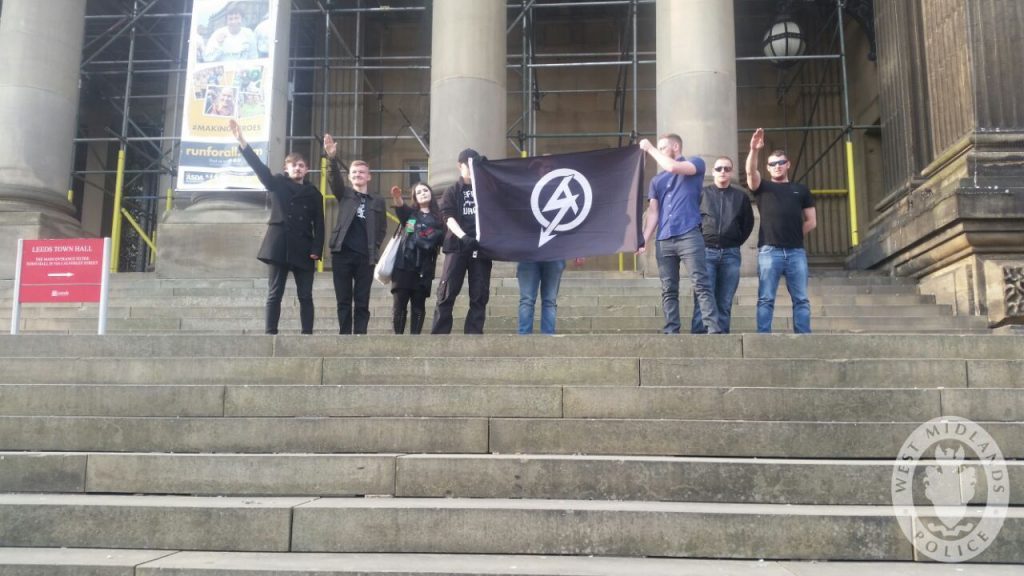 |
 |
What do you think, reader? Here is Alice Cutter, in 2016, as part of a National Action public demonstration (which is how the assembly is described in corporate-media) looking directly at the camera (so she knows the moment is being recorded), and yet later, at her trial, she can be completely unconcerned about claiming she had never been a National Action member? How can this make sense?
To rid ourselves of this problem of incoherence, we can suppose that Cutter did not have any knowledge of the existence of any such photo at the time of the first trial. But how could this be, when she could not have been unaware of i) being at a National Action demonstration in 2016, and ii) having the attendance recorded photographically? For the truth of what is going on, we have Cutter’s insistence of innocence at the first trial as a clue.
When the Leeds Town Hall image first appeared, it wasn’t at the time of the first trial that it did so, because if the image was known to exist at that time, it would have been pasted all over the internet in the corporate-media. In fact, the image did not appear in the public realm until after the retrial, and as it happened, it appears that the emergent nature of the new evidence was something that the official narrative had no option but to incorporate, but using the explanation that the new evidence had existed, but was not known about, and that Cutter was just lying about being in National Action – as evidenced in coverage by the Birmingham Mail:
She claimed never to have considered herself a member, even before the ban, despite attending meetings with group leaders and posing for a Nazi-style salute on the steps of Leeds Town Hall in 2016.
Cutter also attended a demo in York in May 2016.
She initially denied attending until footage emerged showing her standing with other masked NA members, giving the Nazi salute behind a banner that read “Hitler Was Right”.
Just in case of the existence of any doubt, and just for good measure it would seem, there is, as the extract tells, actually more than one piece of emergent evidence against Cutter. Apparently, she can be seen on footage taken at a notorious demonstration at York, which unlike the Leeds one, is something that can be corroborated as having actually happened (more on this in a moment). And yet it is particularly noteworthy, however, that a still from this footage which could prove Cutter’s presence at York does not seem to be in circulation. Moreover, if one searches for images of this event, one will be struck by a feature that would make it very hard to identify Cutter being there: all but a very few of the demonstrators were wearing masks (which, with the professional-looking banner, gives this turn-out an all round production value that is suspiciously high).
According to the court reporting (Daily Mail), Cutter herself can perhaps explain why, if she had been at York on the day, there wasn’t actually any evidence about it – except hearsay regarding the contents of certain video (which is what the author suspects is the case):
But when she attended a demonstration in York – described by leader Chris Lythgoe as a ‘low risk event’ at which ‘women are definitely welcome’ – she was hungover and had to run into a Disney store to ‘calm down.’
‘I felt more ill and I got really dizzy and I had to be walked away by another girl. I left because I was scared and panicking,’ Cutter told the court.
‘I had been sick a lot of times that morning because I was scared and hung over. I went to the Disney shop to calm down.’
Cutter sounds like an ultra dedicated Nazi, does she not? On the contrary, of course, this account makes it sound as if Cutter went to York for the social meet, and on the day after, her feelings of biliousness were exacerbated by her pimply adolescent boy friends (perhaps doing the equivalent of playground push-ups to impress the girls) taking part in a neo-Nazi demonstration – otherwise known as making complete arses of themselves in a public place. And it would certainly accord with the position she had maintained at the first trial regarding her relationship with National Action: that she socialised with some of its membership.
The difficulty that would therefore still exist that would prove a considerable obstacle to convicting Cutter of post proscription National Action membership is probably why we discover that, at the retrial, Cutter completely changed her tune about never having been a member of the group, as the Daily Mail reports (link as above):
Cutter admitted to holding racist views and said she considered herself a member of National Action – at least until December 2016 when it was banned.
Was the new story forced by the newly emerged evidence? Or has something else been going on? Let’s return to the supposed Leeds demonstration at which Cutter was supposedly photographed doing a Roman salute. The first thing we can say about this event is that there is no independent corroboration of it having happened. Hope Not Hate does not mention it in a summary report on National Action activity for 2016. The author, who has been studying National Action since 2017, had been aware of demonstrations in Newcastle, York and Liverpool, but had never heard of one taking place in Leeds. The Wikipedia entry for National Action doesn’t mention it. And to be clear, the event is referred to as a demonstration in the corporate-media – or as a protest, as is the case in the Mail article linked to above:
Nevertheless, she attended another protest in Leeds, where she was pictured on the steps of the town hall giving a Nazi salute.
In the absence of corroboration that the Leeds demonstration took place, it’s quite reasonable to suppose that what we are looking at, in that image of people cartoonishly throwing up Roman salutes, is a flash-mob assembled to take a picture to create the illusion of a demonstration. This phenomenon has been noticed before at FBEL, so it’s not being made up to here to advance an argument. And if the reader will take note of the observation taken from a previous article, this flash-mob activity is precisely for creating an illusion: “‘far-right’ activists do [it] in order to give fuel to those who would have the public believe that there is a ‘presence’ of them in various towns up and down the country”. Bear in mind, then, that in this case, the flash-mob for an illusion serves a purpose of putting Alice Cutter at a National Action demonstration.
As the reader will know, Alice Cutter was entered into the so-called “Miss Hitler” beauty pageant in 2016, and we learn from the Leeds-Live website that the Leeds “protest” was closely chronologically adjacent to it:
Cutter, who is alleged to have been photographed while making a Nazi salute on the steps of Leeds Town Hall during a National Action demonstration on May 9 2016, is said to have entered the contest the following month.
Bearing this information in mind (and note the odd use of “alleged”), the reader is asked to consider the following images. From left to right, the first is Alice Cutter as contestant in the Miss Hitler pageant. The second is Alice Cutter wearing a shawl that was characterised by the prosecution as being offensive, and which was used as evidence of Cutter’s National Action membership, which means that the image must date from the time of her dabbling with the group. The third and fourth are both of Alice Cutter photographed in the vicinity of the court at the time of the first trial. The fifth is Alice Cutter in the vicinity of court at the time of the second trial.
 |
 |
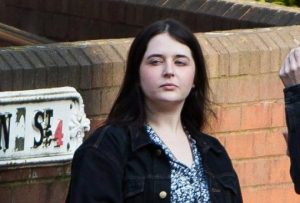 |
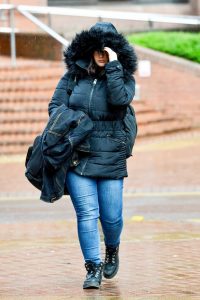 |
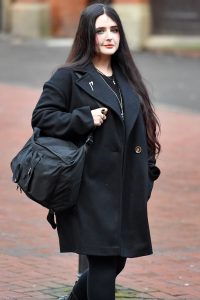 |
Although the Alice Cutter on the steps of Leeds Town Hall is supposedly one month younger than the Alice Cutter who entered the Miss Hitler contest, the reader will be forgiven for thinking that she looks more like the Alice Cutter of 2019 and 2020. To say that in 2019 and 2020, she is no longer her waiflike self of 2016 is verging on considerable understatement (women, like men, can fill out as they get older). And one cannot help but notice that, in Leeds in 2016 (allegedly), as well as looking like her older self, she is not at all thrilled to be there.
The reader’s attention is also drawn to the detail of the scaffolding in the image taken on Leeds Town Hall steps, and see how it appears to retreat back into the building. This is noteworthy information, because it turns out that Leeds Town Hall has been having renovation work on it very recently. In September 2019, the Leeds City Council website reported that “over the past year, the building’s roof has already been undergoing extensive refurbishment which has included work on the iconic clock tower.”
Other crucial information supplied in the same piece is as follows:
Work on replacing and refurbishing the roof and iconic clock tower of Leeds Town Hall began in October 2018 and will continue until November 2020. The current roof dates back to the original structure of the Town Hall which was completed in 1858.
From Monday 3 June 2019 until September 2019, the Victoria Hall was closed to the public while the roof of the auditorium was replaced. Refurbishments to the Victoria Hall roof includes soundproofing to help eliminate external noise pollution for events.
In keeping with the original design the roof, tiles across the building are being replaced with Welsh slate. The roof refurbishment also includes a restoration and update for the huge chandeliers in the Victoria Hall and Vestibule which feature new LED bulbs which are fully dimmable with colour options to enhance flexible lighting states, and comply with a commitment to the environment.
To be clear, the Victoria Hall is on the ground floor of Leeds Town Hall, and the Vestibule will be what it sounds like: an antechamber adjacent to the entrance. It should be noted that, at the start of 2016, there was talk of vital renovation work needed, and that funds were being applied for, but also a perhaps too optimistic idea that ”work could start as early as July this year”, because there doesn’t seem to be any indication online that it did.
And if the reader is wondering if the banner hanging in the background in the flash-mob photo could also be significant for understanding when the photo could have been taken, what is being advertised there is an organisation with a connection to a national supermarket that holds street running races. Although in existence in 2016, the organisation and its link with Asda is still a contemporary item, so it doesn’t rule out the photo having been taken between, say, June and September, 2019.
Tying a number of threads together, then, here we have Alice Cutter, one moment, never a member of National Action, the next, Roman saluting on the steps of Leeds Town Hall, in an image that was new at the second trial. Moreover, it is an image of dubious provenance, it being unclear when it could have been created, and with the image itself betraying evidence that that was not in 2016. The repercussions of the emergence of the image, along with her apparent admission at being at the York incident, facilitates an accusation against Cutter of being in National Action after proscription, since she could never have been shown to be a member at that time, if she could not be shown to ever have been a member. After this, she could fall afoul of the prosecution’s evocation of World War II, and Nazi war crimes, as much as her co-defendants. Compounding the impression we start to form that Alice Cutter was “got at”, there is the very light weight prison sentence (especially compared to that given to mother of new born babe, Claudia Patatas), which out of all the others, is most alike that of Daniel Ward’s. Daniel Ward, to reiterate, changed a not guilty plea, and consequently made things easy for those wanting to prosecute him. It’s doubtful that it would be credible (or even possible) that Cutter could have gone from the first trial, where she could not be found guilty on a not guilty plea, to the second having altered her plea, so the sort of deal that she might have made was to participate in ways and means to incriminate herself.
Having covered this sort of thing for nine to ten years, the author is never shocked by where his own eyes following the evidence leads him. The naïve will have another reaction, but then they wouldn’t know the UK Government to know that it was fully capable of such activity. That being said, the key to understanding what happened in this case is the Leeds Town Hall photo, and if there is any reason, by dint of any detail that is shown in it, by which the date of its taking can definitively be placed in 2016, then by all means, reader, get in touch and let it be known.






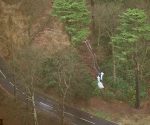
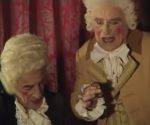











I’ve been a photographer (both film and digital) for nearly 40 years.
It is my opinion that photo 1 and 2 is a different girl to the ones shown in 3, (possibly) 4 and 5. Cutter has a thin upper lip in photo 3, but in the black and white photo she has a fat upper lip. Unless she used botox, the girl in the black and white photo can’t be Cutter. Cutter also has a wide jaw that miraculously disappears in the black and white photo and turns into a pixie jaw. Cutter has slanting eyes and I find it hard to believe she managed the “wide eyed look” in photos 1 and 2 although it’s not impossible. I’d say they used at least 2 different actresses.
The Town Hall shot was definitely taken when the Town Hall was shut to footfall. Getting a shot without a single person getting in the way indicates a Sunday (or a lot of patience).
To find out when the shot was taken the digital file would have to be forensically examined to determine whether or not the digital date had been altered (very easy to do). Digital photos should not be allowed into a trial unless it’s made clear to the jury that they are evidentially very weak or the file has been subjected to a professional examination.